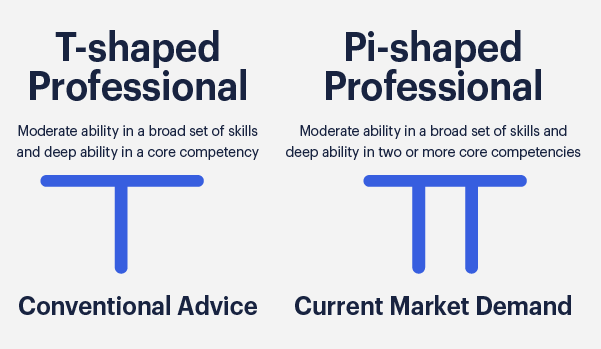Learn about purchasing for teams

Professionals need to have multiple deep skill capabilities instead of one, according to the insights in the recently released "Skills in the New World of Work" report.
While agilists and scrum teams have long understood the value of T-shaped skills (the vertical line of the T represents a deep primary skill while the horizontal line represents a broad range of secondary skills), the report uncovered rising employer demand for pi-shaped skill sets (two or more areas of deep expertise and a broad range of supporting skills).

Source: "Skills in the New World of Work" report
Pi-Shaped vs. T-Shaped Skills
At the dawn of the modern era, Henry Ford and Fredrick Taylor shaped a way of working that highly valued processes and tools over people and interactions.
This way of working required high specialization in a single type of skill (what we could call the I-shaped professionals), as human beings became easy-to-replace resources in an industrial machinery. Those resources could be easily swapped if necessary without negatively affecting the entire process.
Although this approach was successful for several decades, the evolution of our world in a variety of ways, such as styles of government, society, the market, technology, and education, caused a disconnection between the industry and its context. Thanks to this disconnection, agile was born.
Agile is based, among other characteristics, on self-managed and cross-functional teams. To avoid the risks associated with the I-shaped professionals (i.e.: the work of the entire team could stop if just one member stopped working for any reason), a lot of those self-managed, cross-functional agile teams started to experiment with cross-polinization so that those I-shaped professionals started to learn new skills, at least at a basic level, from their colleagues. Thus, the idea of the T-shaped professional was born.
But frankly, nowadays, a T-shaped professional skill set (deep specialization in a single skill with basic knowledge of other skills) is not enough because, in today’s world, user needs and technology are changing at the fastest pace possible. So those professionals have continued their evolution to what today we call the pi-shaped professionals: professionals that are eager to learn not only the basics of a pair of skills apart from their main skill but also become experts on those new skills, becoming peers with those originally specialized professionals on those skills.

An Example: Building Our New House
Imagine that you have good terrain on a good property and want to build your brand-new house on it. In order to build the house, you may need bricklayers, electricians, plumbers, door and window installers, interior decorators, and landscapers.
Based on traditional management ideas, you could contract a team formed by a specialist on any of those required skills (one bricklayer, one electrician, one plumber, etc.). But if at some point any of them suffer from an accident, takes a holiday, or even wins the lottery, the rest of the team won’t be able to continue building your house until you find some other specialist, and even worse, the new specialist will need time to understand and learn the work performed by the previous one (this is what we use to call the bus factor risk).
To reduce this risk, and based on conventional advice you may have received in the past, you decide to make those I-shaped specialists start working in pairs, in a rotatory pattern, so any of them will be able to learn (at a basic level) the rest of the skills needed to build the house. Now, your team members will be T-shaped professionals. While it may look like you have reduced this “bus factor” associated risk, it's only on the surface. If a non-basic, specialized task must be performed while one of your specialists is absent, then the knowledge and experience of the rest of the team members may not be enough.
So, how can you really reduce this “bus factor” risk? Developing those pi-shaped professional skills within your team.
How to Develop Pi-Shaped Professional Skills
The main ingredient to become a cross-skilled or pi-shaped professional is having the motivation to achieve that goal. High motivation will bring you the energy and focus you’ll need to recognize and take advantage of the opportunities to learn new skills and continue your evolution, even when you may be overwhelmed by the amount of work you have.
As a secondary ingredient in this recipe, you will need to be able to rely on your teammates, to learn from them, or to delegate part of your responsibilities to them so that you’ll find the time to experiment, learn, and practice your new skills.
Although this learning-new-skills approach may put, at first, more pressure on your team, with time it will allow you to better self-manage as a team and as a cohesive unit, reduce your risks, and improve the way you are dealing with the expected work to be done.
Download the "Skills in the New World of Work" Report
To read more about employer demand for pi-shaped work competencies and to get insights about today's world of work, please complete this form and download the report.











